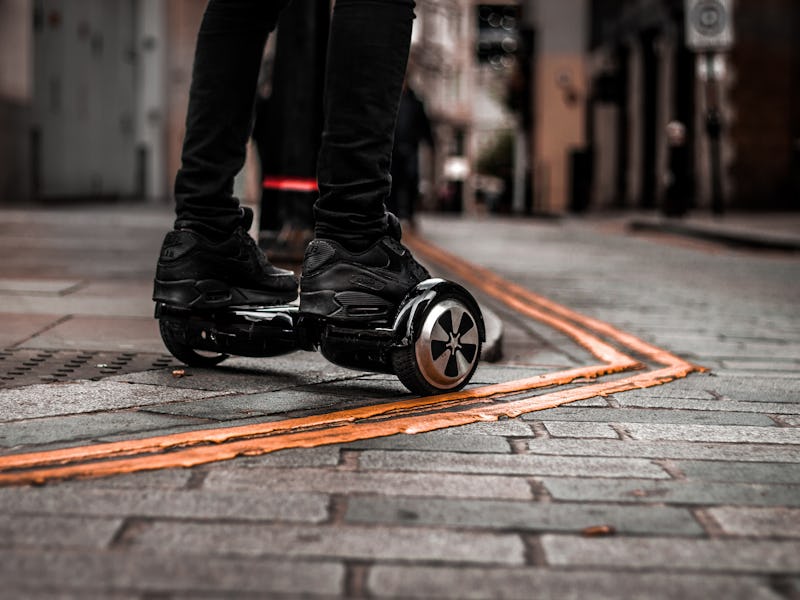Why Hoverboards Are Probably Destined to Fail
Gernsback predicted we'd all be riding "electric skates" by 1975. Why aren't we?

In 1925, Hugo Gernsback wrote a piece titled “Fifty Years From Now,” which appeared in the San Antonio Light, a newspaper from San Antonio, Texas.
In this piece he gave readers “A glance ahead at the surprises science has in store for us and a prophetic picture of our great American cities half a century hence.” By the year 1975, he predicted, our buildings would be warm in the winter and cool in the summer. We know that this came to pass. Some of his other predictions, though, were a bit further from the mark. One such prediction postulated that every pedestrian would use electric skates as a form of expedited transportation.
“Each pedestrian will roll on electric skates, such as have been constructed even today,” he predicted. “An insulated wire running from the skate to the head or shoulder of the skater will be sufficient to take the power from the radio power line, and we shall then all be propelled electrically at a pace at least four or five times as fast as we walk today.”
Illustration from "Fifty Years From Now"
In theory, it’s not a bad idea. Walking is time-consuming, if sort of integral to the upkeep of our bodies. Theoretically, something like Gernsback’s electric skates might help alleviate the stress on public transportation for short trips, cut down on the use of automobiles in situations where point A and B are only a few miles apart, and even solve some of the road congestion and maintenance infrastructure issues that we are (not) dealing with .
That said, there are a number of pitfalls that accompany the electric skates plan, which is probably why we aren’t all skating to work, even 40 years after Gersnback predicted we would be doing so.
It’s The Law
One of the biggest reasons why we’re not scooting around on electrically propelled personal transport vehicles is because its illegal. At least in some places. Airlines, Disney parks, college campuses, New York City, and a host of other places have put the kibosh on hoverboards and motorized skateboards. Why?
A lot of it has to do with the “motor vehicle” distinction, which is mostly fuzzy and not totally settled. Hoverboards are pretty damn fast, and even in the hands (or feet, as it were) of an “experienced operator” (if there is such a thing), they’re not foolproof. On sidewalks, they pose dangers to walking and running pedestrians. On the street, they’re likely to cause traffic problems and endanger bicyclists, drivers and their riders.
Hoverboards and motorized personal transportation devices exist in a gray area, caught between pedestrian and traffic laws. And so, plenty of places have seen fit to just ban them all together.
While this may change with regulations and stipulations like speed limits and protective gear, it’s difficult to imagine hoverboards catching on as a form of personal transportation without some major changes to the way we get ourselves around.
It’s Us
We’re part of the problem, too, for a couple of reasons.
First, hoverboards aren’t foolproof and as humans, we are sort of inherently foolish.
But perhaps the biggest reason is the same one that ultimately caused segways to falter and fail: nobody wants to be “that guy”.
Wired’s Jordan Golson laid it out pretty plainly:
“The Segway worked as advertised, but it was awkward to use. It was small enough to ride inside a building or into an elevator, but at 100 pounds, it was too heavy to carry up stairs. It also required the rider to be “that guy” (and it was almost always a guy), rolling his electric scooter around the lobby and corridors of his office building. And then you need to park it.”
With something like hoverboards, which sort of fly in the face of both nature and convention, adoption is going to be uneven, with the early adopters being the ones who are okay with being “that guy” and everyone else being those willing to roll their eyes as “that guy.”
It’s a problem of perception as much as it’s a problem of convenience, though. Hoverboards present some of the same problems as Segway, though on a smaller scale. They don’t weight 100 pounds, but they aren’t light, with most averaging about 25 pounds. Then there’s the issue of where to put it. Do you really want to ride it to a bar to meet friends for drinks and have to be the person stashing his or her hoverboard under the table or by the bar? Probably not.
Conceivably, we could come up with something like bike racks for hoverboards or some kind of large-scale and conveniently placed locker system, but again, that’d required pretty widespread adoption and cities that are willing to play along and spend precious tax dollars on appropriate infrastructure. Not likely.
Electric skates didn’t become ubiquitous by 1975 like Gernsback predicted they might, and they still haven’t today, 91 years after the publication of “Fifty Years From Now.” It’s difficult to see them gaining any mainstream momentum, but the prediction itself wasn’t too terribly out there. With the right regulations and infrastructure, maybe things could’ve been different. Maybe in an alternate future.